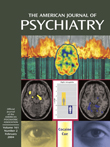To the Editor: Dr. Kapur provided an interesting review of “the emerging understanding regarding the role of dopamine as a mediator of motivational ‘salience’” (p. 13). But can ideas that emerged well over a decade ago
(1,
2) still be “emerging” today? It is, of course, possible that Dr. Kapur is unaware of these forerunners; at any rate, he does not cite them.
Dr. Kapur states his central proposal as follows: “In psychosis there is a dysregulated dopamine transmission that leads to stimulus-independent release of dopamine. This neurochemical aberration usurps the normal process of contextually driven salience attribution and leads to aberrant assignment of salience to external objects and internal representations” (italics in original) (p. 15). In considering the relationship of this proposal to “other models and ideas,” he states further that none of them “specify how this dysregulation leads to symptoms” (p. 18). In contrast, he claims that his model “provides a heuristic for ‘consilience’…between the neurochemical biology of psychosis and the…experience of psychosis” (p. 17).
My colleagues and I made a similar proposal in 1991, in greater anatomical and physiological detail and with similar claims for bridging the neural basis of psychosis to its symptoms. This article
(2) appeared in a widely cited journal,
Behavioral and Brain Sciences, whose exacting refereeing process ensured that we made proper reference to our own forerunners. It did not pass unnoticed. Over the period 1991–1999, it was the eighth most frequently cited article in schizophrenia research (http://esi-topics.com/schizophrenia/papers/a1.html). Its authors, including David Hemsley, Joram Feldon, and myself, have developed, applied, and reviewed these initial ideas in further publications (e.g., references
3–
6). We also proposed a number of empirical tests of our hypotheses. One, a disruption of latent inhibition by augmented dopaminergic transmission in the nucleus accumbens, investigates just that process of “aberrant assignment of salience to external objects”—or “spurious novelty”
(7)—that is central to Dr. Kapur’s model. One might have expected him, therefore, to seek support in, or at least discuss, the abundant data concerning disrupted latent inhibition gathered since 1991 in numerous experiments with both animal and human subjects
(4–
7). Instead, in a lone mention, he dismisses latent inhibition as a “model of attentional habituation” (p. 18), a simplistic account that was considered and dismissed in our 1991 authors’ response to multiple peer review in
Behavioral and Brain Sciences (2). We stressed then, just as Dr. Kapur did, the critical role of
contextual dependence of salience attribution, applying this concept in particular to latent inhibition and its disruption.
There is insufficient space in a brief letter to provide further details of these parallels (they are available upon request). It will no doubt seem to some (as it does in part to me) pettifogging to mention them, but science is a collective enterprise. We each place only a small brick in the wall—all the more reason that one should note carefully how much of the wall has been built already by others.

